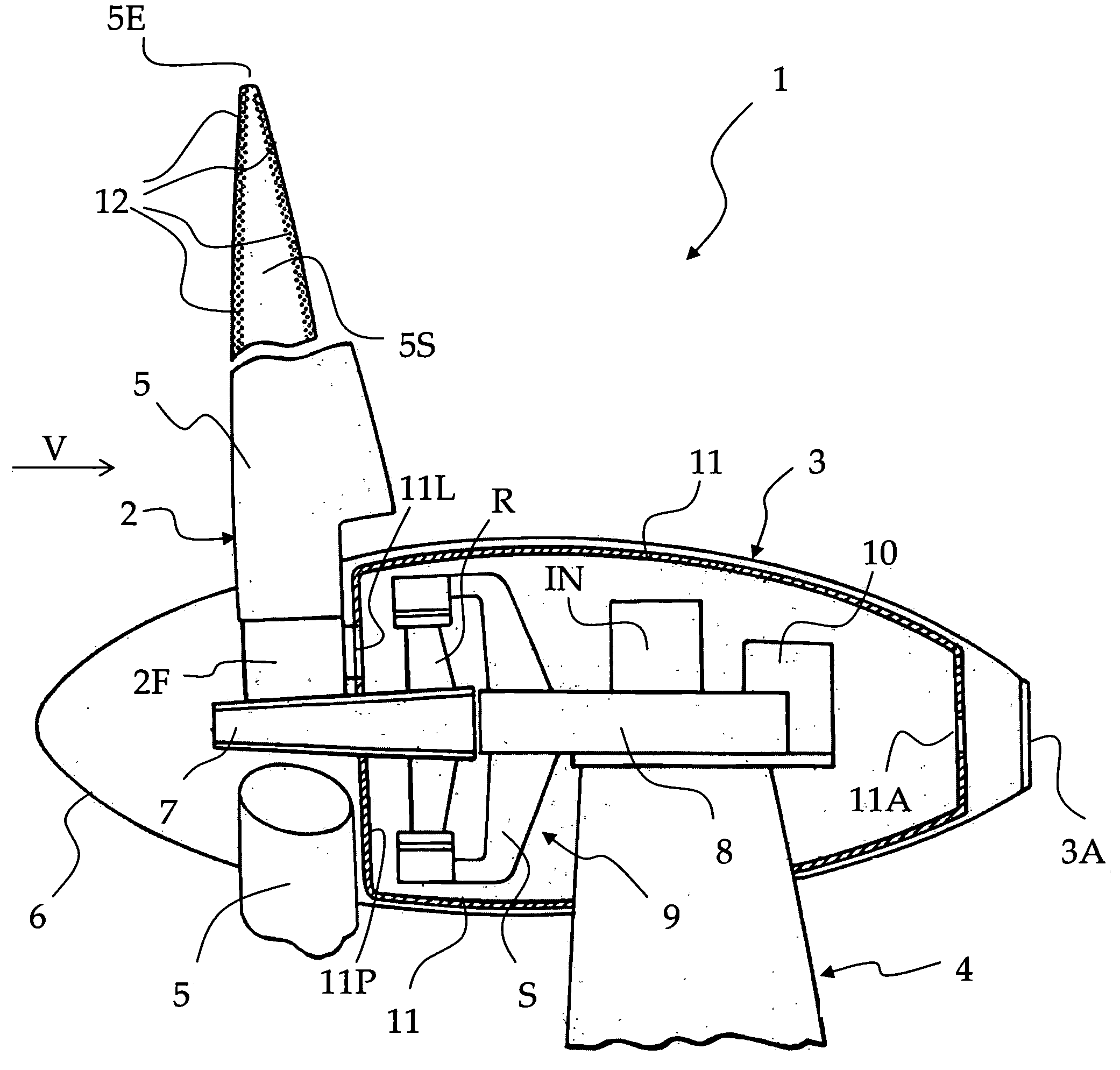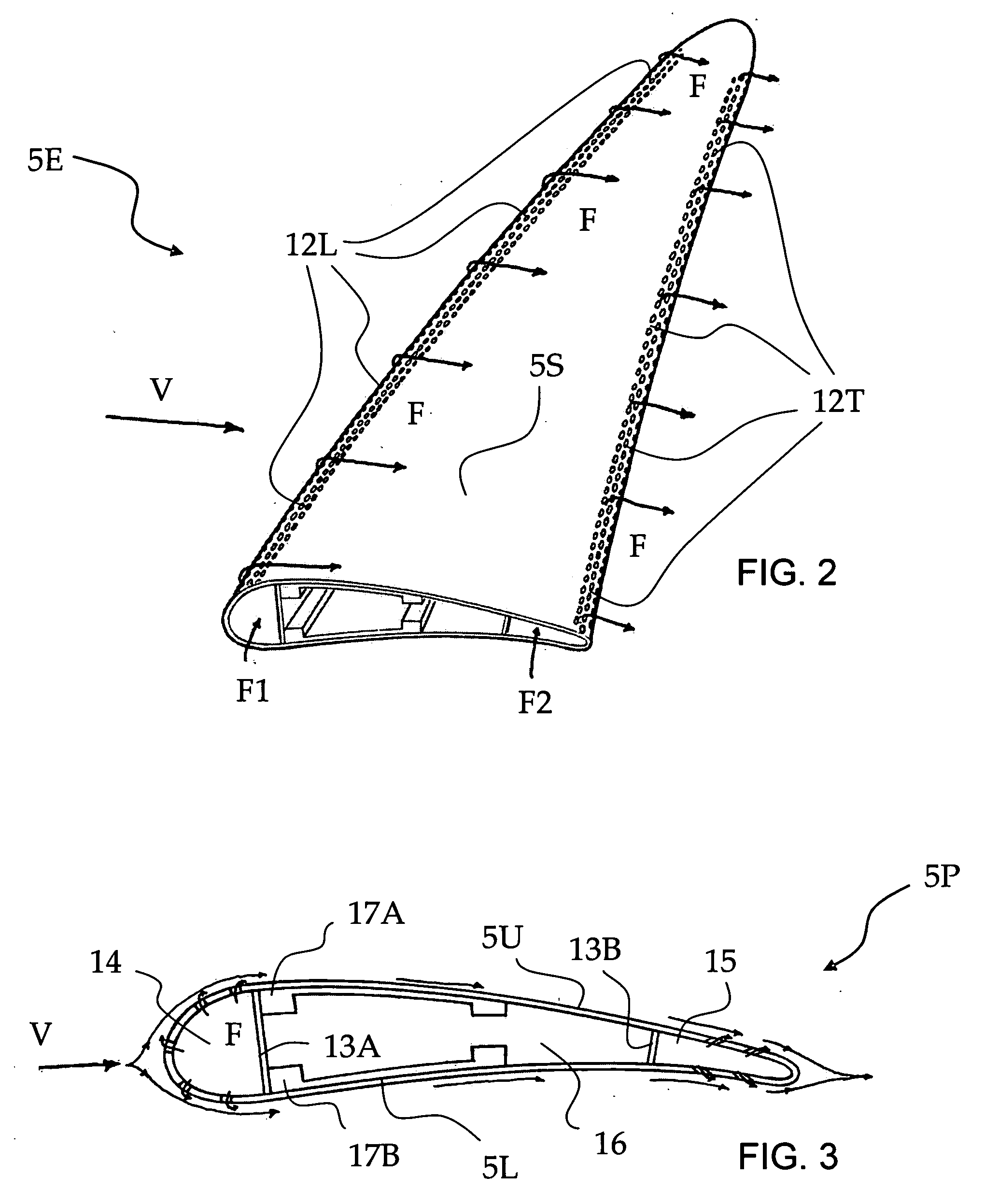Ice accretion on the profile of a wing, and more specifically on a wind
turbine rotor blade, seriously affects its fluid-dynamic characteristics.
In particular, ice accretion affects the lift and the drag of both the blade and the overall structure, and thus, remarkably changes the pressure distribution along the relevant surfaces.
Often it is very difficult to foresee how factors such as lift, drag and pressure will change depending on the deposit of ice on those surfaces.
In instances of ice accretion, consequently, the blade in operation undergoes different flexion and torsion stresses, which typically result in a remarkable decrease in the overall aerodynamic efficiency of the wind
turbine.
In addition, ice accretion also affects the blade, due to the increased and different masses distribution caused by the ice, such that it completely modifies the static and dynamic behavior of the blade.
Moreover, in ice accretion conditions a significant problem arises relating to the WECS safety, both as it relates to the safety of people or property near to the
system, and to the possibility of
system failure or breakdown.
In fact, in situations where the turbine is in operation and the blades are functioning and have ice on their surfaces, it may happen, in a fully unforeseen manner, that ice pieces come off from the blades.
In such situations, the following are possible results: 1) objects or people around the system are hit by pieces of flying ice; and 2) suddenly and unforeseeable structural stresses are generated, essentially of an aeroelastic nature.
In the first instance, due to the dimensions of
current generation WECS, where the rotors may extend to be ninety meters in
diameter and the towers may reach one hundred meters in height, in conditions where ice comes off the blades in sudden and unforeseeable fashion, the pieces of ice become projectiles, taking off like bullets from the blades, and having the capacity to cause remarkable damage to the surrounding environment.
When the WECS is in operation, vibrations of aeroelastic nature can generate significant
structural stress both on a single blade of the system and on the system as a whole.
In instances where ice cannot be adequately removed by means of available de-icing devices, WECS systems are only used during a limited number of days per year, particularly when that are installed in areas where
ice formation is common.
As night time is the most
critical period for ice accretion, however, these systems are the least effective at the time when they are most needed.
However these systems have drawbacks such that they are typically used only in research or educational applications.
More specifically, Type II systems use a complicated ice accretion control and management mechanism.
The complexity, cost, reliability and maintenance problems of Type II systems, consequently, are remarkable in the long run.
In such cases, the actual efficiency of the system is drastically reduced, and provides a rather unsatisfactory yield in critical operating conditions.
A further drawback of the Type II system is that when idle, that is, when the rotor is moving without
electric power being produced, the
electric power needed to prevent or eliminate the ice accretion has to be taken by the electric grid, and the system is unprofitable in these conditions.
The thermo-conducting sheets that are glued to the blade surface of the Type II system also
wear out very easily, thus they often require maintenance work and reduce the availability of these systems.
Lightning can seriously damage the de-icing and anti-icing arrangement as well as the
electric devices associated with the system and, in some cases, cause failure of the rotor on which the
lightning discharges.
In addition, once the thermo-conducting sheets are electrically powered, they generate very strong electrostatic rotary fields, and create
pollution and undesired
electromagnetic noise effects around the WECS.
Another significant
disadvantage of Type II systems is that any guarantee given by the manufacturer of the wind turbine is lost once a de-icing and anti-icing arrangement is incorporated onto or within in the blade structure.
The consequent manufacturing and maintenance costs reach prohibitive levels, which, together with a not certainly high
total efficiency of a Type II system, thus make it decidedly unprofitable.
Assuming that it is possible to attain such a level of power, the wind turbine equipped with such a system, will nonetheless still show a very low efficiency when there is the danger of icing.
The use of fans inside rotating elements of such Type III systems is known to be highly discouraged by fan manufacturers as well as there is a
high probability of malfunction and breakdown due to the effect of Coriolis forces on the rotating parts of the fan.
This model has the
disadvantage that it is rather complicated and difficult to carry out because it uses intermediate fluids for realizing the thermal exchange between the
waste heat of the
electric devices and the circulating air inside the blade.
Moreover it has also the same drawback discussed with respect to the German patent, i.e. that the remarkable thickness of the blade, constituted by poor conducting materials, do not guarantee an effective and efficient heating of the surfaces of the blades.
Furthermore, the heat supplied by means of the
forced circulation of the fluid
stream inside the
electric devices is certainly not sufficient for avoiding the problem of the ice accretion in particularly critic environmental conditions.
To be underlined is certainly the poor material
thermal conductivity constituting the blade, which remarkably jeopardizes the effective heat exchange between the fluid
stream and the blade body.
In synthesis, even complicating the construction of the blade with the
insertion of thermally conductive metallic parts, which shall reach the far end of it, the arrangement appears of poor effectiveness.
The
efficacy increases if a great amount of electric power is taken from the electric grid in order to heat up the blade bodies of the wind turbines, with the
disadvantage of having a poor
total efficiency of the WECS in critic operating conditions.
Summing up, it is indeed the type of
heat transmission chosen, namely the heat
internal convection from the blade body to the outside surface, which represents the main limit for the de-icing and anti-icing effectiveness.
This method of heating, in fact, leads to the use of large amounts of thermal power for the desired purpose, and to not being able to send heat only to the particular surface areas of the blade concerned by ice.
 Login to View More
Login to View More  Login to View More
Login to View More 


